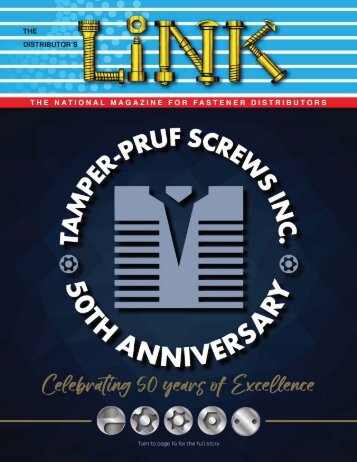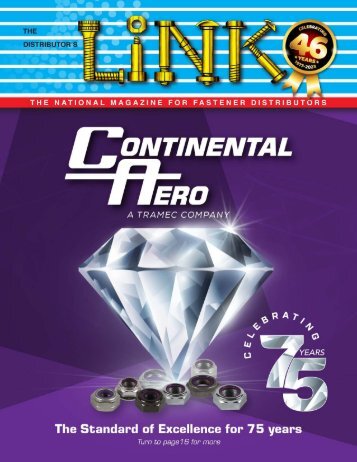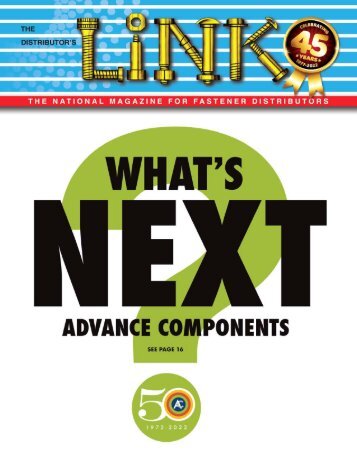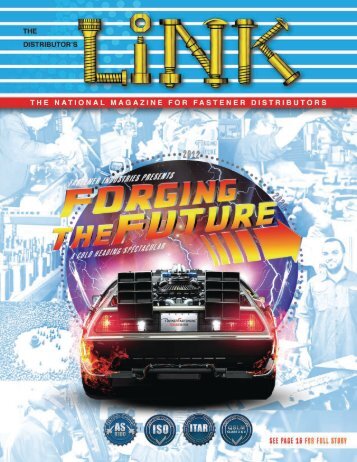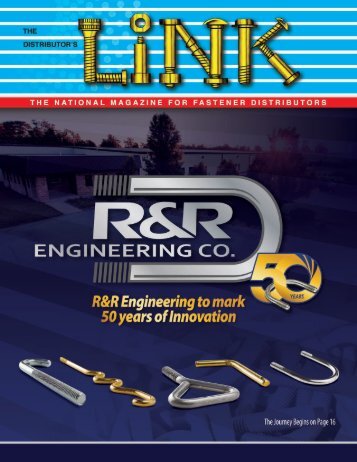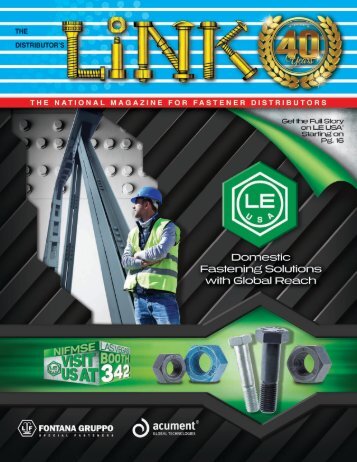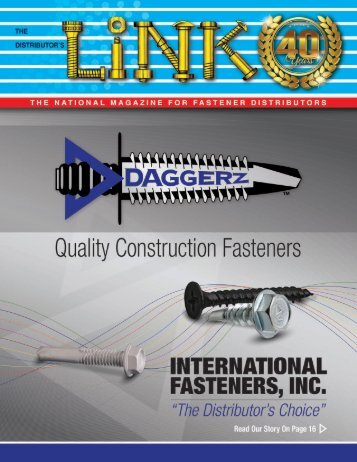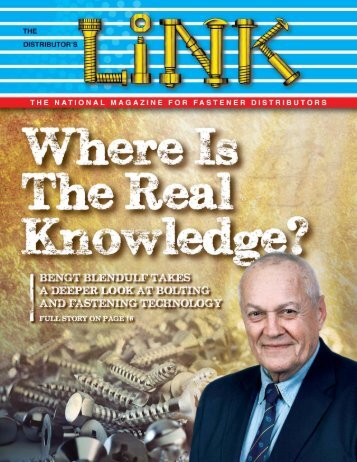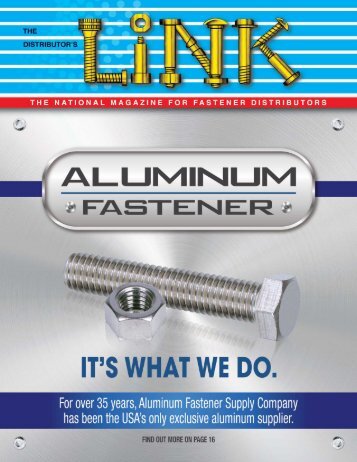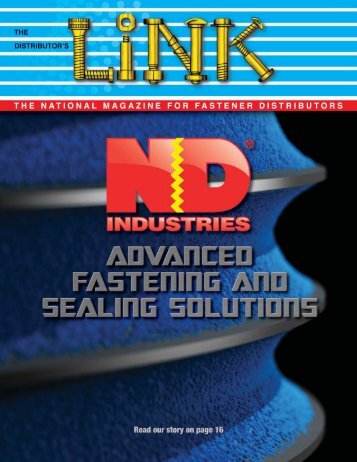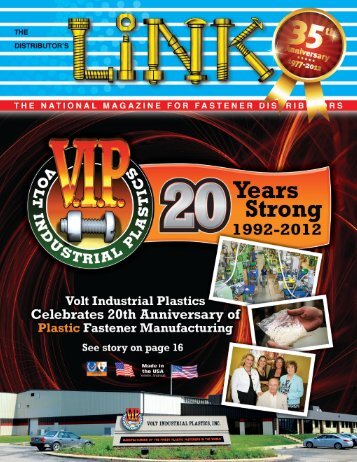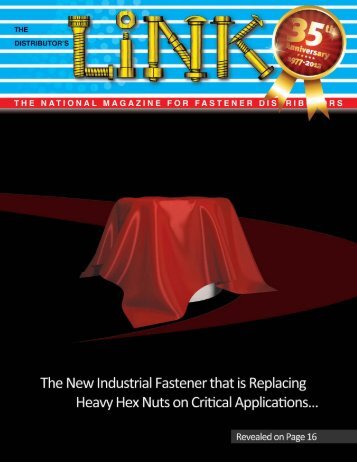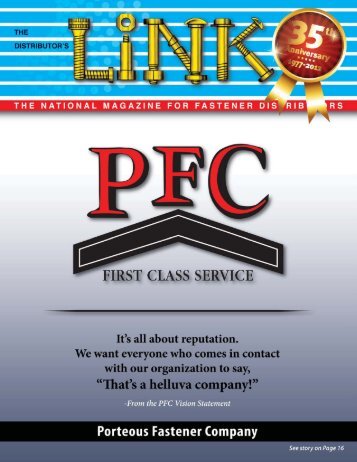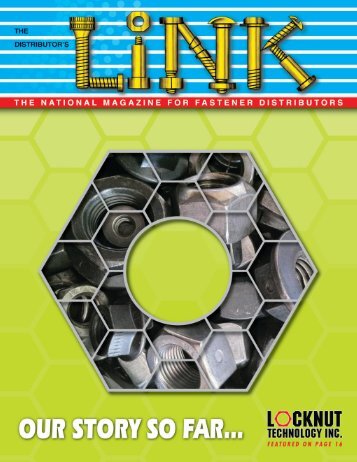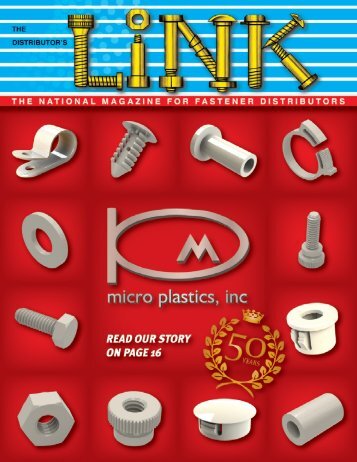SPRING 2019
- Text
- Wifi
- Manufacturing
- Continued
- Products
- Fatigue
- Industrial
- Association
- Distributors
- Fasteners
- Fastener
154 THE DISTRIBUTOR’S
154 THE DISTRIBUTOR’S LINK BENGT BLENDULF THE GOOD AND BAD USE (ABUSE) OF METRIC STANDARDS from page 98 The kilometer is pronounced with the accent on “i” and not on the “o” as most uneducated reporters say it. If you say kilo and then meter and just put them together like you just said it, it will be correctly pronounced. Area Again, the meter being the base unit, we can use mm², m², km² or whatever would suit conversion of in², ft², acre and so on. Temperature The kelvin unit, K, is the SI base unit, but should only be used in scientific contexts. Degree Celsius (°C) is the SI additional unit replacing degree Fahrenheit (°F). The Celsius scale is simply based on water either freezing at 0°C or boiling at 100°C. The Fahrenheit scale is pure nonsense in my opinion. Don’t use centigrade instead of Celsius, this was an old term used by pharmacists a long time ago. A couple of easy reference points: -40 is the same in °C and °F (much too cold either way), +10°C equals 50°F, +16°C = 61°F and “room temperature” +20°C is 68°F. Force N or newton (low case always) replaced all old “metric” terms like kilogram force and kilopond. It is a relatively small unit, 1 pound force (lbf) is approximately 4.5N (4.4482 exactly). For practical purposes we normally use a prefix like k for kN (thousand newtons) or M for MN (million newtons), etc. Mass (Weight) One kg (kilogram) equals 2.2046 lb (pound). Don’t use kilo to indicate kilogram, kilo is a prefix simply meaning 1000. The Europeans, who should know better by now, are very sloppy with this, let’s try to be better (shall we?). Why we use lb (libra from Latin) for pound and oz (onza also from Latin) I simply don’t know. Do you? Volume Use liter (L) for liquids (gasoline, wine, soda pop, etc.). Otherwise, in technical matters use mm³, m³ and similarly cubed metric units. 1 L = 1 dm³. 1 US gallon is approximately 3.8 L (3.7854 exactly). Pressure/Stress The derived SI unit pascal (Pa) is used worldwide for barometric, hydraulic and other types of pressures. For mechanical properties, like strength of materials, N/mm² was used by ISO and most industrial countries. For reasons unknown to me, ISO and ASTM have adapted the pascal unit as MPa instead of N/mm² for mechanical properties. The rational for using N/mm² is that the stress is defined as a force (in this case N) applied to a cross sectional area (in this case mm²). Since everyone in the world knows (??) that MPa = N/mm², this should not be a problem, but why can’t we have the same expressions for all technical standards to avoid trouble? The United States, is after all a major member of ISO, The International Organization for Standardization. Torque/Moment of Force For tightening of most sizes of fasteners we use newton meter (Nm) or other suitable combinations of N and length of moment arm. A Final Note In this modern and high tech age, why would a pilot of a commercial airliner tell the passengers the speed of the airplane in knots?!? The knot (kn) is a term (not SI, of course) coming from the old sailing ship era where knots were tied on a line every 47 feet 3 inches apart. The line was attached to a chip log (weighted on one end to make the thing stand up – sort of) which was cast over the stern of a moving vessel/ship. A 30-second sand-glass (later 28 second) was then used to time how many such knots passed by to indicate speed. One knot, by the way, is based on 1.85166 m (one nautical mile) per hour. With the use of modern, precise information from GPS and Doppler radar, this knot business is pure nonsense. There is, unfortunately, a 1969 United States Federal Aviation Regulation for airworthiness standards mandating use of nautical miles (1852m) and knots. To be meaningful it also has to be combined with the Mercator projection world map to make any sense for navigation. So, if a pilot reads this, please spare your passengers this unnecessary information and tell them your speed (in air and over ground) in km/h. Keep the knot inside the flight deck (used to be called cock-pit). To my dear Link readers: I don’t mind if you make a copy of this article and send it to your Congress- and/or Senate representative. They passed the metric law and should get moving on implementing it, it is more than 30 years overdue. We pay these people for this! BENGT BLENDULF
THE DISTRIBUTOR’S LINK 155
- Page 6 and 7:
in the Spring 2019 issue of 6 DISTR
- Page 8:
6 THE DISTRIBUTOR’S LINK Stamping
- Page 12:
10 THE DISTRIBUTOR’S LINK Joe Dys
- Page 16:
14 THE DISTRIBUTOR’S LINK Laurenc
- Page 19 and 20:
After the trade show I researched w
- Page 22:
WIFI Wearables was introduced in 20
- Page 26:
24 THE DISTRIBUTOR’S LINK COMPUTE
- Page 30:
28 THE DISTRIBUTOR’S LINK Jim Tru
- Page 34 and 35:
32 THE DISTRIBUTOR’S LINK Bruno M
- Page 36:
34 THE DISTRIBUTOR’S LINK FASTENE
- Page 40:
38 THE DISTRIBUTOR’S LINK FASCOMP
- Page 44:
42 THE DISTRIBUTOR’S LINK Advance
- Page 47 and 48:
THE DISTRIBUTOR’S LINK 45
- Page 50:
48 THE DISTRIBUTOR’S LINK MID-WES
- Page 53 and 54:
THE DISTRIBUTOR’S LINK 51 Endries
- Page 55 and 56:
THE DISTRIBUTOR’S LINK 53
- Page 58:
56 THE DISTRIBUTOR’S LINK BIG RED
- Page 61 and 62:
THE DISTRIBUTOR’S LINK 59
- Page 64:
62 THE DISTRIBUTOR’S LINK Roman B
- Page 68:
66 THE DISTRIBUTOR’S LINK INTERNA
- Page 71 and 72:
THE DISTRIBUTOR’S LINK 69
- Page 73 and 74:
ZAGO MANUFACTURING INC. DEALING WIT
- Page 76 and 77:
74 THE DISTRIBUTOR’S LINK COMPONE
- Page 78 and 79:
76 THE DISTRIBUTOR’S LINK SWD Inc
- Page 80 and 81:
78 THE DISTRIBUTOR’S LINK John R.
- Page 82:
80 THE DISTRIBUTOR’S LINK SPIROL
- Page 85 and 86:
INTERNATIONAL FASTENERS, INC. SPRIN
- Page 88:
86 THE DISTRIBUTOR’S LINK SOUTHWE
- Page 91 and 92:
THE DISTRIBUTOR’S LINK 89 NEFDA H
- Page 94 and 95:
92 THE DISTRIBUTOR’S LINK INFASCO
- Page 98:
96 THE DISTRIBUTOR’S LINK EPICOR
- Page 101 and 102:
BTM MANUFACTURING BTM’s U-BOLT CO
- Page 103 and 104:
The NEFCO Corporation, a leading di
- Page 105 and 106: MAFDA CHRISTMAS GALA BRANDYWINE PRI
- Page 108 and 109: 106 THE DISTRIBUTOR’S LINK COMPUT
- Page 110 and 111: 108 THE DISTRIBUTOR’S LINK GUY AV
- Page 112 and 113: 110 THE DISTRIBUTOR’S LINK JIM TR
- Page 114 and 115: 112 THE DISTRIBUTOR’S LINK METROP
- Page 116 and 117: 114 THE DISTRIBUTOR’S LINK ROB La
- Page 118: 116 THE DISTRIBUTOR’S LINK BRUNO
- Page 121 and 122: MWFA/PAC-WEST/NFDA JOINT CONFERENCE
- Page 124 and 125: 122 THE DISTRIBUTOR’S LINK NELSON
- Page 126 and 127: 124 THE DISTRIBUTOR’S LINK Jo Mor
- Page 128: 126 THE DISTRIBUTOR’S LINK FASTEN
- Page 131 and 132: THE DISTRIBUTOR’S LINK 129 New PE
- Page 134 and 135: JOANNE GOODMAN- SHERMAN EDITH CAMER
- Page 136: 134 THE DISTRIBUTOR’S LINK ROMAN
- Page 141 and 142: THE DISTRIBUTOR’S LINK 139
- Page 143 and 144: fastenerlinks BRINGING YOU THE FAST
- Page 145 and 146: fastenerlinks BRINGING YOU THE FAST
- Page 148 and 149: 146 THE DISTRIBUTOR’S LINK SPIROL
- Page 150 and 151: 148 THE DISTRIBUTOR’S LINK DISTRI
- Page 152 and 153: 150 THE DISTRIBUTOR’S LINK BAY SU
- Page 154 and 155: 152 THE DISTRIBUTOR’S LINK NORTH
- Page 158: 156 THE DISTRIBUTOR’S LINK JOE DY
- Page 161 and 162: THE DISTRIBUTOR’S LINK 159 J.W. W
- Page 163 and 164: THE DISTRIBUTOR’S LINK 161 The Bo
- Page 165 and 166: THE DISTRIBUTOR’S LINK 163
- Page 167 and 168: MWFA/PAC-WEST/NFDA JOINT CONFERENCE
- Page 169 and 170: THE DISTRIBUTOR’S LINK 167 SC Fas
- Page 171 and 172: Navy SEAL…Army Ranger… Air Forc
- Page 173 and 174: THE DISTRIBUTOR’S LINK 171 LAUREN
- Page 175 and 176: THE DISTRIBUTOR’S LINK 173 LARRY
- Page 177 and 178: NFDA COME TO CINCINNATI IN JUNE FOR
- Page 179 and 180: THE DISTRIBUTOR’S LINK 177 JO MOR
- Page 182 and 183: 180 THE DISTRIBUTOR’S LINK FAST-E
- Page 184 and 185: 182 THE DISTRIBUTOR’S LINK J.W. W
- Page 186: MWFA HOLIDAY PARTY MEDINAH BANQUETS
- Page 190: advertisers index D DARLING BOLT 13
- Page 194: advertisers index R RAF ELECTRONIC
Inappropriate
Loading...
Mail this publication
Loading...
Embed
Loading...
|
SHARE A PAGE FROM THIS MAGAZINE OPTION 1: Click on the share tab above, or OPTION 2: Click on the icon (far right of toolbar) and then click on the icon (far right of toolbar) and then click on the  icon (top right of the page). icon (top right of the page).
|
View Archives
Copyright © Distributor's Link, Inc. All Rights Reserved | Privacy Policy







